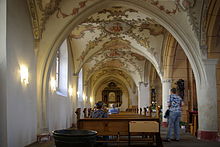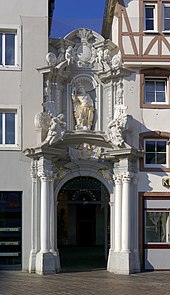St. Gangolf (Trier)


St. Gangolf is the market and town church of Trier , consecrated to St. Gangolf . After the Trier Cathedral , it is the oldest church in the city. It is located behind a row of houses south of the main market .
history
The first market church, built in 958, was replaced by a new building between 1284 and 1344. Today's late Gothic building emerged from a renovation that began around 1500. Baroque elements were added in 1731 and 1746. The painting of the altar wall by August Gustav Lasinsky dates from the 19th century ; it is the most important monument of Nazarene art in Trier. The stained glass windows by Charles Crodel in 1966 brought together the elements of the different epochs in one overall picture.
The church has always been almost completely surrounded by houses and only the east side almost borders a street (Grabenstrasse), but even here there are low-level shops, popularly known as "Gädemcher" .
The main entrance to the church is at the foot of the church tower and, like the entrance in the side aisle, can be reached through a small baroque gate (created in 1731/32 by the Augustinian Josef Walter) from the Trier main market .
organ
As early as the beginning of the 17th century, St. Gangolf had a one-manual organ of French-Dutch style, the builder of which is unknown. In 1829 a new, two-manual organ in baroque style was inaugurated, which had been built by Franz Heinrich and Carl Stumm . This organ was replaced in 1898 by a new instrument from the organ builder Breidenfeld , which was completely destroyed in 1944.
Today's organ on the west gallery of St. Gangolf was built in 1972 by the organ building workshop Johannes Klais (Bonn). The instrument has 35 registers ( slider drawers ). The Spieltrakturen are mechanically, the Registertrakturen electrically.
|
|
|
|
|||||||||||||||||||||||||||||||||||||||||||||||||||||||||||||||||||||||||||||||||||||||||||||||||||||||||||||||||||||
- Coupling : I / II, III / I, III / II, I / P, II / P, III / P
- Playing aids : six mechanical typesetting combinations
tower
The first four floors of the west tower were built at the beginning of the 14th century. In 1507, thanks to a foundation from the mayor's widow Adelheid von Beßlich, the two upper floors with the tower gallery and the four small corner turrets were added. As the west tower with its 62 meters towers over the towers of the Trier cathedral, Archbishop Richard von Greiffenklau had the south tower of the cathedral added.
Bells
The so-called rag bell is best known among the bells of St. Gangolf . Cast by Nicolaus von Ene in 1475 , it strikes every evening at 10:00 p.m. and, as elsewhere, got its name because it started the evening curfew earlier. The bell belongs so much to Trier's local culture that its sound was even heard in the first radio broadcast from Trier on June 16, 1930 over the airwaves of the Frankfurt station .
St. Gangolf also houses the "Zündel" bell, a fire bell from the Middle Ages . In the event of a fire, the town's two tower keepers had the task of pointing in the direction of the fire with a flag during the day and a lantern at night. The last tower keeper worked here until 1905. In addition, there are four other ringable bells hanging in the tower: the Marien, Josef, St. Barbara and St. Paulinus bells. The church tower clock still has three small, bright-sounding bells that together make a minor chord. The striking notes of the overall ring are h °, c sharp ', e', f sharp 'and g sharp'.
graveyard
The priest and journalist Georg Friedrich Dasbach is buried in the small priest cemetery of St. Gangolf after his remains were reburied there in 1959 from the municipal cemetery. He died on October 11, 1907 in Bonn. In 1875 Dasbach founded the Sanct-Paulinus-Blatt , today's diocese newspaper Paulinus .
literature
500 years of St. Gangolf church tower in Trier, parish Liebfrauen / Hans Wilhelm Ehlen (ed.), Trier 2007, ISBN 978-3-7902-0184-0
Web links
Individual evidence
- ^ The Trier Church of St. Gangolf. Trier Organ Point, accessed on February 3, 2016 (more information on the history of the organ).
- ↑ a b City Hall newspaper Trier of May 8, 2007, p. 1.
- ^ Entry on Sankt Gangolf (Mitte-Gartenfeld, Trier Hauptmarkt) in the database of cultural assets in the Trier region ; Retrieved February 3, 2016.
- ↑ Hermann Leist: When the bells ring brightly. In: Trierisches Jahrbuch 1956. Trierisch e. V., pp. 63-69 , accessed January 31, 2007 .
- ^ Rhenish history . Retrieved March 9, 2017.
- ↑ - Sarland biographies . Retrieved March 9, 2017.
Coordinates: 49 ° 45 ′ 22.4 " N , 6 ° 38 ′ 26.8" E






